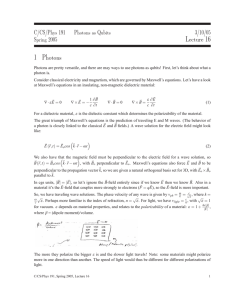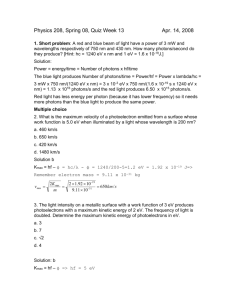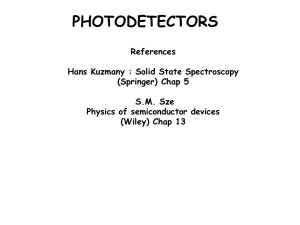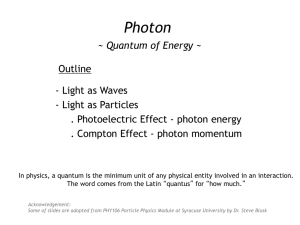Photons and Planck`s black body radiation law
advertisement
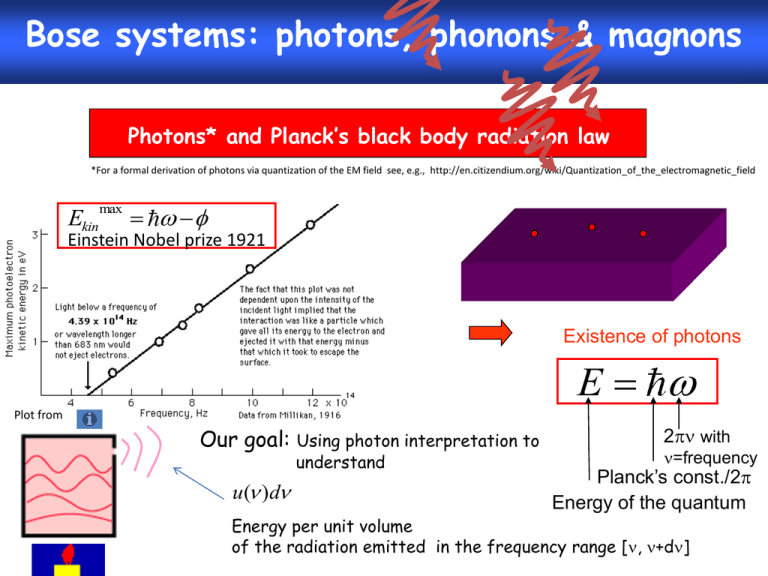
Bose systems: photons, phonons & magnons Photons* and Planck’s black body radiation law *For a formal derivation of photons via quantization of the EM field see, e.g., http://en.citizendium.org/wiki/Quantization_of_the_electromagnetic_field Ekin max Einstein Nobel prize 1921 Existence of photons E Plot from Our goal: Using photon interpretation to understand u( )d 2 with =frequency Planck’s const./2 Energy of the quantum Energy per unit volume of the radiation emitted in the frequency range [, +d] Standing EM waves = modes characterized by wave vector k of plane wave solutions eik r Each mode can be occupied with a certain # nk,s of photons nk,s of photons classical amplitude of the standing wave s=1,2 takes into account the two linear independent polarizations With this and the individual photon energies k , s 1 Total energy in the cavity E k ,s nk ,s k ,s nk ,s E0 2 k ,s k ,s Index of a particular microstate characterized by the occupation #s ..., nk , s ,... E j n j E0 with j k , s j Let’s first take advantage of the fact that we know the BoseEinstein distribution function already U E j n j E0 j j j e j 1 E0 We derive the same result with the partition function of the canonical ensemble Energy fluctuations Z e E e E0 e jnj e E0 j e 1n1 2 n2 ... n1 , n2 ,.. E j n j E0 j 1 e E0 1 e 1 1 1 e 2 1 1 e 3 With Z 1 E0 ... e j 1 e E E e j 1 Z ln Z E e Z F S Of course consistent with U=F+TS when using F=-kBT lnZ and T V ln Z With U E E e E e U U E ln 1 e 0 j j E0 j je 1 e j j E0 j j e j 1 The dispersion relation for light propagating in vacuum reads: k ,s c k speed of light Reveals: light frequency is independent of the polarization state s and the direction of propagation U E0 j j e j 1 E0 k ,s k ,s e k ,s 1 E0 2 k k e k 1 Let’s evaluate the k-sum If we impose periodic boundary conditions for the electric field wave E E0 e i k r t such that Lx i k r Ly L z kx Lx 2 nx 2 i k r k , k , k k y Ly 2 ny x y z e e L L Lz x y kz Lz 2 nz Lx Ly Lz 1 V 2 ... dk dk dk ... dk dk dk ... 4 k dk ... k x y z x y z 3 3 k x k y k z 2 2 V 4 k 2 dk 2 # of modes between k and k+dk Density of states in k-space D (k )dk 3 We will learn other techniques to calculate the density of states for more complicated dispersion relations. U E0 2 k E0 2 k e k 1 E0 2 D(k ) 0 4 k 2 2 3 e 0 With: (k ) c k d dk k V U E0 k 1 V u c 3 2 3 e 1 d 3 2 e k 2 1 with x 0 x3 x3 4 u 3 3 4 2 x dx with x dx c 0 e 1 e 1 15 0 1 1 dk dk c 0 e U E0 Defining the energy density u V c k d Internal energy of the box at T, relative to the vacuum energy (e.g., responsible for the Casimir effect) d dx u u ( )d 0 2 kB4 15c3 3 T4 If we asked for the spectrally resolved u( )d we obtain from inspection of u 2 c3 2 u 3 e 1 d c 0 3 8h 3 0 e h 1 d c3 0 e h 1 d 4 3 2 8h 3 u ( )d 3 d Planck’s spectral energy density c e 1 Image from: http://en.wikipedia.org/wiki/File:Max_Planck.png It is useful to write it down with the differential to remember how to do the correct transformation to u ( )d 8h u ( )d 3 d c e 1 3 u ( ) d 8h c 5 1 e hc / 1 d For experimental comparison we need to know not what is the spectral energy density insight the box, but what radiates out into one hemisphere: z Photons leaving the hole in direction in the time t come out of max depth of c cos t A c cos c cos t c #Photons leaving the hole in direction in time t A c cos t Fraction of photons in solid angle d=sindd is d / 4 Energy emitted into hemisphere in time t Act U V /2 With sin=x 0 2 1 Act d d cos sin U 4 2V 0 /2 d cos sin 0 Act Act Act U x dx U u 2V 0 4V 4 1 Lambert’s cosine law* The emitted intensity is defined emitted energy per area A and time t I u With u Act c u 4 At 4 k 2 15c3 4 B 3 I T4 2 k B4 60c 2 3 T 4 T 4 Celebrated Stefan-Boltzmann law A second look at the derivation of Planck’s law k U E0 2 D(k ) 0 e k 1 dk 2 d D() 0 # of modes with frequency [,+d ] 1 e 1 Photon energy # of photons excited in each mode The concept of density of states Continuous volume element in isotropic k-space D(k )dk V 2 3 4 k 2dk Region in k-space occupied by a quantized state: Lx Ly Lz k x k y k z 2 2 2 k y 2 L k x From density of states in k-space to density of states in energy or frequency space D(k )dk V 2 (k ) c k 3 4 k 2dk k With dispersion relation, here for photons and dk c Simple substitution yields d c D( )d d 2 V 2 However, k-space not always isotropic 4 c 3 c more general approach D( ) ( (k )) Property: when integrating over [, +d ] we obtain the k number of states in this interval (k ) c k 4V V 2 2 ( (k ))dk 4 k ( ( k )) dk D( ) ( (k )) k 3 3 2 c 2 k Here D( ) 4 V 2 2 c 3

